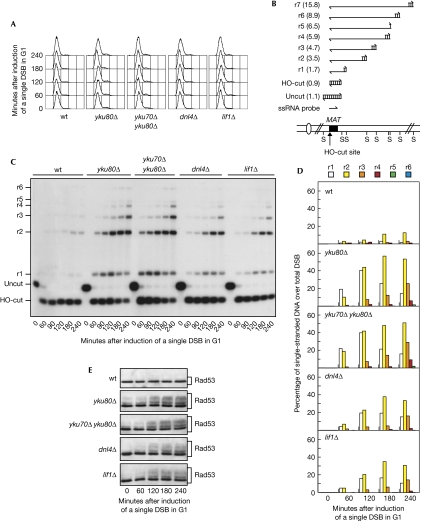Figure 1.
The absence of non-homologous end joining allows double-strand break resection in G1. YEP+raf α-factor-arrested cell cultures of wild-type JKM139 and yku80Δ, yku70Δ yku80Δ, dnl4Δ and lif1Δ derivative strains were transferred to α-factor-containing YEP+raf+gal to induce HO expression (time zero). (A) Fluorescence-activated cell sorting analysis of DNA content. (B) Schematic representation of the system used to detect DSB resection. Gel blots of SspI-digested genomic DNA separated on alkaline agarose gel were hybridized with a single-stranded RNA probe specific for the unresected strand at the MAT locus, which shows HO-cut and uncut fragments of 0.9 and 1.1 kb, respectively. 5′-to-3′ resection progressively eliminates SspI sites located 1.7, 3.5, 4.7, 5.9, 6.5, 8.9 and 15.8 kb centromere-distal from the HO-cut site, producing larger SspI fragments (r1–r7) detected by the probe. (C) Analysis of ssDNA formation as described in (B). (D) Densitometric analysis of the representative experiment shown in (C). Three independent experiments were performed with similar results. (E) Western blot analysis of protein extracts with Rad53 antibodies. DSB, double-strand break; ssDNA, single-stranded DNA; wt, wild type; YEP, yeast extract peptone.

